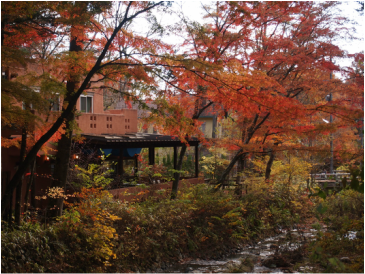 Foliage and river view of Kyu-Karuizawa Foliage and river view of Kyu-Karuizawa Airbnb, a globally popular platform to find private rental houses, has some recognized popularity in Karuizawa, too. If you simply search "Karuizawa" in Airbnb, you can find more or less 30 private houses and their hosts who rent a whole or a part of their houses to visitors. Design of those houses looks very Karuizawa unique and should be fun to stay. You can find a small cottage look house in forest, or a spacious luxury villas with beautiful garden if you have enough budget. In most facilities (as far as I went through the search listings), the host of the facility lives nearby, and seems to manage check-in and -out process directly. On the other hand, some of them (facilities which are owned by remote owners) seem to outsource such process to a local property management company, and to operate like a hotel. Though the number of those Airbnb registered facilities is limited yet, I think these services are worth trying for people who want to experience Karuizawa life before considering to relocate. You may also be able to socialize with the host and their families, and learn a lot about the local life. From house owners point of view, Airbnb is practically the only platform choice to rent the houses to short term lessees currently. In early 2014, Yahoo Japan launched an Airbnb-like private house rental brokerage services for vacant Karuizawa villas. However, that service was forced to end after a month from its launch, when Nagano prefecture administration guided Yahoo Japan and its Karuizawa local property management partner company to stop the operation due to its illegality. Though there is nothing clearly defined in relevant national laws, the prefectural administration has so far guided industries to obtain a hotel business permit (which requires strict administrative check on face to face check-in and -out processes, fire safety, etc.) if they are to offer short term facility rental service for the period of less than a month. So currently, other Karuizawa vacation rental services than those on Airbnb are operated under this rule; i.e, to contract a rental service agreement for the service period of a month and longer, and a hotel service agreement for that of less than a month. Double standards exist in the industries, where only Airbnb is allowed to brokerage short term house rental without the hotel business permit while others are not. Very strange, but it is the fact today. In October 2015, Abe administration began discussion to deregulate these inconsistent regulations on private house rental services to accommodate imminent needs by increasing number of foreign visitors to Japan. It is reported that the administration will set consistent national rules by June 2016. I personally watch the trends in short term villa rental services and its deregulation with strong interest. Not only will it serve to the travelers' and seasonal residents' convenience, but also it will revitalize the town by reducing the number of unused vacant villas. I hope Karuizawa could see a new potential for growth by a right policy.
0 Comments
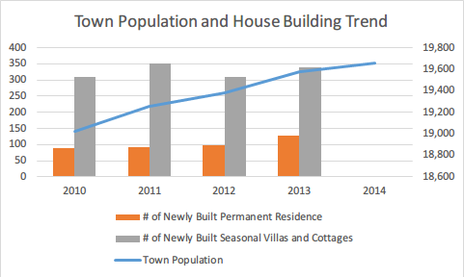 Souce: Karuizawa Town Administration and Ministry of Internal Affairs and Communications Souce: Karuizawa Town Administration and Ministry of Internal Affairs and Communications In my previous post, I wrote the number of Tokyo commuters from the town is growing. Today, I like to show you the town itself is also growing. The graph at the left shows the growth in town population and house building statistics for last 5 years. The number itself is small at 19,657 in 2014; however, it should also be remarked that Karuizawa achieved more than 14% growth in population for last 10 years (it was 17,173 in 2005). This fact is regarded very phenomenal in recent trend of population shrink in this country. When you look at that number in comparison to the house building statistics, you will find another fact. The number of newly built permanent residence is 129 and that of seasonal villas and cottages is 338 in 2013, something which make total of 467 house constructions. This takes roughly 2.4% of town population. I studied the similar ratio in Tokyo metropolitan and Nagano prefecture. Tokyo is roughly 0.4% while Nagano is 0.5%. You will see how actively people are flowing in, and having their house in the area. 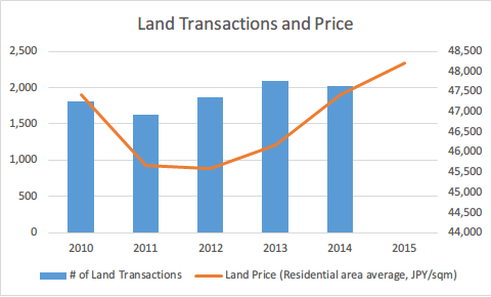 Source: Ministry of Land, Infrastructure, Transport and Tourism Source: Ministry of Land, Infrastructure, Transport and Tourism As people are flowing in, local real estate market is picking up. Even after the Abenomics economic policy reform was implemented in 2013, generally speaking, Japanese local areas outside three major metropolitan areas of Tokyo, Osaka, Nagoya, are still seeing a problem in their local economy recovery. Land transactions have not picked up, and land prices have been going down for these couple of years. However, in Karuizawa, the trend seems to follow that of those metropolitan areas. Land prices started to pick up in 2013 as the steady growth in land transactions continues. In 2015, only Karuizawa shows positive annual growth of 1.6% in land price index for residential areas among all the municipalities in Nagano prefecture. The same index for overall Nagano prefecture was -1.8%, and it was 1.3% in Tokyo, 2.0% in Nagoya, and -0.1% in Osaka. You can see how actively and quickly people are starting to spend and invest their money in the real estate here, as national economy is picking up. I took a quick look at those trends in other Japanese famous resort areas, like Niseko, Nasu, Hakone, Okinawa, etc. Okinawa seems to follow the similar trend with the one in Karuizawa, but other areas seem to be still struggling. Besides the economy, Karuizawa real estate has another important risk of Mount Asama eruption. In 2008 and 2009, Mt. Asama erupted and then the local house construction and real estate indices went down by a couple of percents. This year, Mt. Asama is observed to start pluming actively again. We should carefully watch it, but I hope nothing serious would happen. When Mr. Alexander Croft Shaw, a Canadian missionary, arrived in Karuizawa and built the first summer house in town in 1888, it might be enough to have a house with such a simple design and structure to spend only a summer season here. Today, Karuizawa has become one of the preferred places to live in the area, and how to find or build a good house which can cope with significant variation in temperature for seasons is becoming important. I continue with my story on house building. Pictures from my house during construction are shown above. I discussed with my architect on how to maximize thermal insulation and earthquake-proof performance while minimizing construction cost. In the end, we adopted 25 cm thick of Rockwool insulation for a ceiling, 10 cm of Urethane insulation for walls, and triple glazed sash windows. According to the architect, it is rare to build a house with this level of insulation performance though it may be common in Hokkaido (northernmost island of Japan).
I have been living in my new house for almost a year since I moved in November, 2014. During summer, inside the room is very cool since the walls and windows shut out heat by sunshine. During winter, only one unit of a direct vent oil heater in the first floor heats all the rooms in both first and second floors. It is warm enough. Even when it is - (minus) 10 degrees in Celsius in the early morning outside, without turning the heater on, temperature inside the room is around (plus) 10 degrees in Celsius. It is not so bad. Since we do not use electricity to heat the house, energy cost went significantly down, compared to when I lived in my previous rental apartment. My electricity bill was roughly 40,000 JPY monthly during winter in the rental apartment with electric heating, but it is now less than 20,000 JPY monthly during the winter and even less during the summer. I think it is reasonable enough as an energy cost of standard independent house (i.e., non-condominium type residence). My local friend, Kevin, is famous in town for promoting his house as "Passive House" where energy cost is actually, negative. See his story in Renewables International magazine. His house follows the German standard by Passivhaus Institut, and has 28 cm of insulation in walls and 60 cm in ceiling. By generating and selling electricity by solar panels on the roof, his house's energy cost is reportedly negative. It is incredible achievement in this severe seasonal environment. Finding a stylish and design-conscious house should be easy in Karuizawa, when you search in real estate information services on the web. There are many architects who are advertising their capabilities to design luxury and modern taste villas. Appearance tends to be the most important factor for villa buyers, while the house performance tends to be overlooked. I hope more house buyers would care the house performance equally, especially if they care the quality of resort time in this relaxing town. |
�
Widget above will translate the blog content to your browser languages. If you do not like it, stop it by pressing "x".
Click to vote this blog for Nihon Blog Mura ranking.
Archives
April 2016
Categories |
[English Home] [日本語ホーム] [中文首頁]
Resort Innovation Inc.
ARK Kyu Karuizawa Village II, 2nd floor,
2023-2 Nagakura, Karuizawa, Kitasaku 389-0111, JAPAN
Phone: 0267-27-0046 E-mail: [email protected]
Resort Innovation Inc.
ARK Kyu Karuizawa Village II, 2nd floor,
2023-2 Nagakura, Karuizawa, Kitasaku 389-0111, JAPAN
Phone: 0267-27-0046 E-mail: [email protected]
Copyright 2015-2024 by Resort Innovation Inc. All rights reserved.

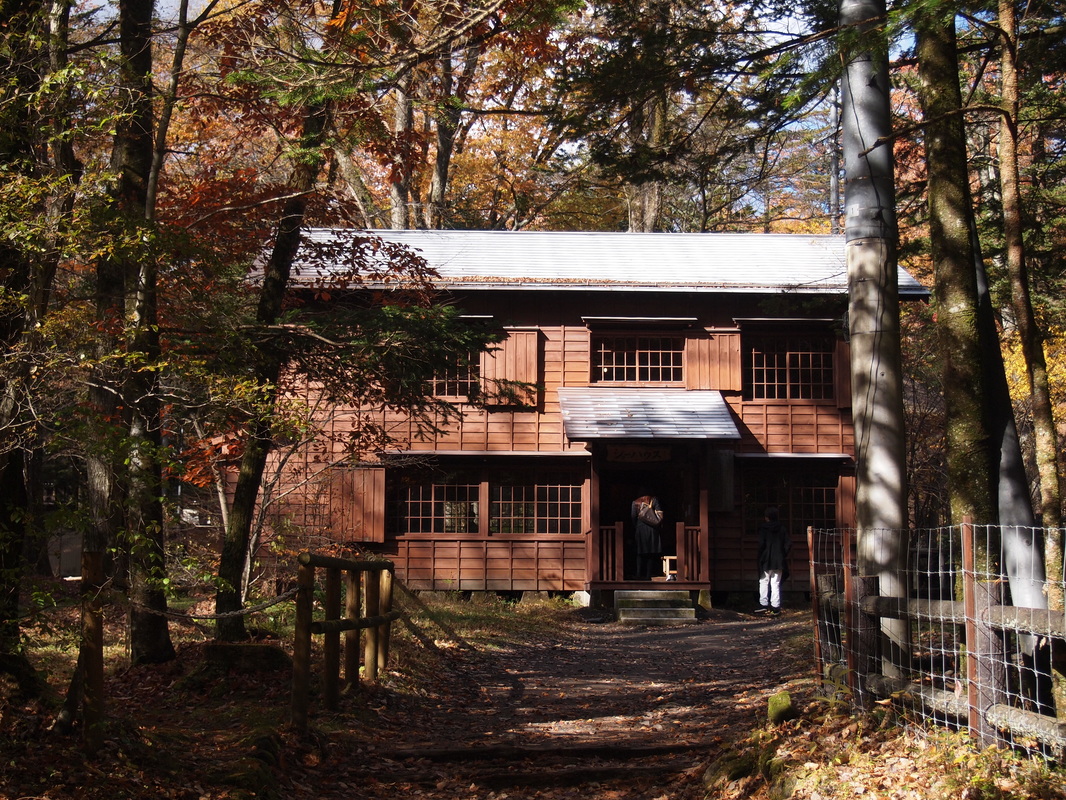
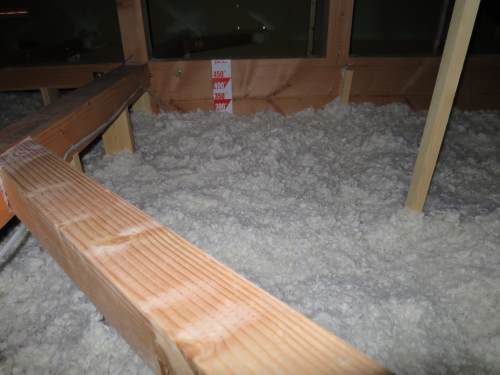
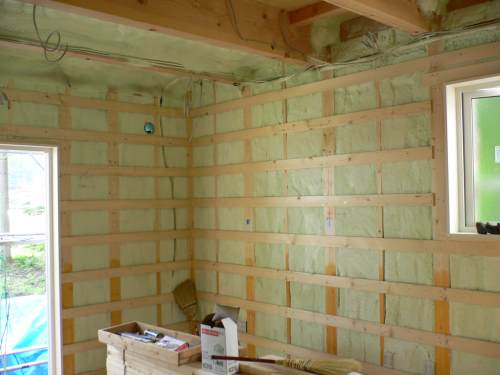

 RSS Feed
RSS Feed